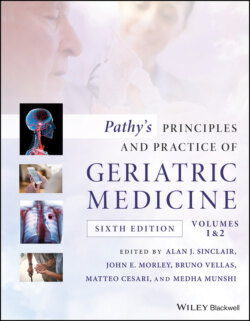Читать книгу Pathy's Principles and Practice of Geriatric Medicine - Группа авторов - Страница 192
Exercise and cognitive function
ОглавлениеThere is a growing body of observational data and experimental evidence that physical activity can significantly influence a wide range of cognitive functions.111,112 The earliest lines of evidence were provided by cross‐sectional studies of athletes or physically active individuals versus sedentary controls, with active or fit individuals demonstrating superior performance in tests of reaction time, motor control, and visual‐spatial tasks. Changes in executive‐control processes and brain structures and functions most closely related to these processes are disproportionately affected by ageing and exercise in some studies.113,114 This has led to speculation that age‐related cognitive dysfunction might be partially mediated by suboptimal and diminishing participation in physical activity across the lifespan. Virtually all of these studies have focused on cardiorespiratory fitness (maximal oxygen consumption) or aerobic exercise as the putative protective factor. However, ~50% of the variance in maximal oxygen consumption in children and adults is thought to be mediated by genetic factors rather than physical activity patterns,114 raising the possibility that shared predisposition to low fitness, vascular risk factors, and cognitive decline may explain these associations, rather than adaptation to an active lifestyle. In addition, changes in maximal oxygen consumption with ageing are explained as much by losses of muscle mass (sarcopenia) as they are by losses of cardiovascular reserve, suggesting that non‐aerobic activities could be just as important as aerobic activities for the prevention of cognitive decline.
More recently, well‐designed prospective cohort studies that have controlled for many known risk factors for cognitive dysfunction have in large part supported cross‐sectional associations between physical activity patterns and risk of dementia.112,115 For example, in the Honolulu–Asia Ageing Study,116 2257 physically capable, cognitively intact men < 71–93 were followed for 7 years for incident dementia. Walking significantly reduced the risk of dementia in a dose‐dependent fashion, with a 1.8‐fold increased risk for those who walked less than 0.25 miles per day compared with >2 miles per day, controlling for other possible risk factors.
Acute exposure to even one bout of aerobic exercise may improve cognitive test performance and reduce depressive symptoms and anxiety. It is not known how long such acute bout effects persist, whether weightlifting exercise has similar acute effects on cognition, or what proportion, if any, of chronic exercise effects are explained by cumulative acute bout effects. Animal data demonstrate that voluntary wheel running (not stressful forced swimming) is a powerful means to enhance neural plasticity and function, improve learning and memory, and increase the availability of brain‐derived neurotrophic factor (BDNF), the formation of new neurons and synaptic transmission in the hippocampus. Exercise also protects against the neurotoxicity of ageing, stress, cortisol, or oestrogen withdrawal in these animal models and potentiates the beneficial effect of oestrogen and antidepressants on hippocampal volume and metabolism.
A recent meta‐analysis found that physical exercise protected against physical decline with an effect size of 0.62.117 Exercise also slows decline in people with Alzheimer’s disease.118 Aman and Thomas119 found that supervised exercise reduced agitation in nursing home residents. Importantly, it is clear that not all exercise is alike and that low‐intensity, minimally progressive, mostly unsupervised regimens such as employed in the recent DAPA (Dementia and Physical Activity) trial120 may provide no cognitive benefit at all. As these types of regimens do not address other common comorbidities such as falls, frailty, depression, sarcopenia, osteoporosis, cardiometabolic disease, etc., there would appear to be little rationale for their use in aged care settings or cohorts with established dementia.
Potential mechanisms by which exercise could improve cognitive function include changes in fitness, increased cerebral blood flow, reduction in depression, increase in presence or activity of neurotrophic factors (BDNF, insulin‐like growth factor‐1 [IGF‐1]), downregulation of neurotoxic factors (C‐reactive protein, cortisol, interleukin‐6 [IL‐6]), and other inflammatory cytokines and prevention or better control of chronic disease (e.g., stroke, diabetes, cardiovascular disease). Considering the non‐robust nature of most of the interventions reported in Heyn et al.’s121 meta‐analysis of cognitively impaired elders, it does not appear that increases in aerobic capacity are required for cognitive benefits to accrue, as was previously thought. Cognitive benefits seen after non‐aerobic exercise also cast doubt on a central role for aerobic capacity.2 Exercise does increase cerebral blood flow acutely, as do cognitive tasks, and increased frontal cortex capillary density has been observed in animal models after exercise training, suggesting a possible common pathway for improved brain oxygenation and, thereby, function. Many of the most promising mechanisms in animal models have yet to be confirmed in human studies, however. Further exploration of the potential mechanisms of benefit in this crucial domain of health and function is needed, including studies linking changes in cerebral blood flow, depressive symptoms, self‐efficacy, physical fitness, or burden of chronic disease and disability to cognitive changes associated with exercise participation.
Recent studies have suggested a potentially more important role for resistance exercise in cognition that was previously thought. For example, a meta‐analysis of randomised controlled trials by Kelly122 of various exercise modalities in healthy adults found that aerobic exercise had no significant benefit in any cognitive domain, whereas resistance training was associated with improvements in reasoning, and Tai Chi with attention and processing speed. In adults with mild cognitive impairment (MCI), resistance exercise but not aerobic training improved executive function compared to a stretching control group in the EXCEL trial.123 In the SMART study,124 high‐intensity resistance training for 6 months improved global and cognitive function in older adults with MCI compared to sham exercise (calisthenics), a benefit that persisted over 18 months. In this same study, changes in lower extremity strength mediated 64% of the benefit in executive function in the training group,24 whereas gains in aerobic capacity were unrelated. Such findings again suggest a pathway of anabolic adaptation linking brain and musculoskeletal adaptations in this cohort, although the precise morphological and functional connectivity adaptations underlying cognitive benefit remain to be fully elucidated.125
